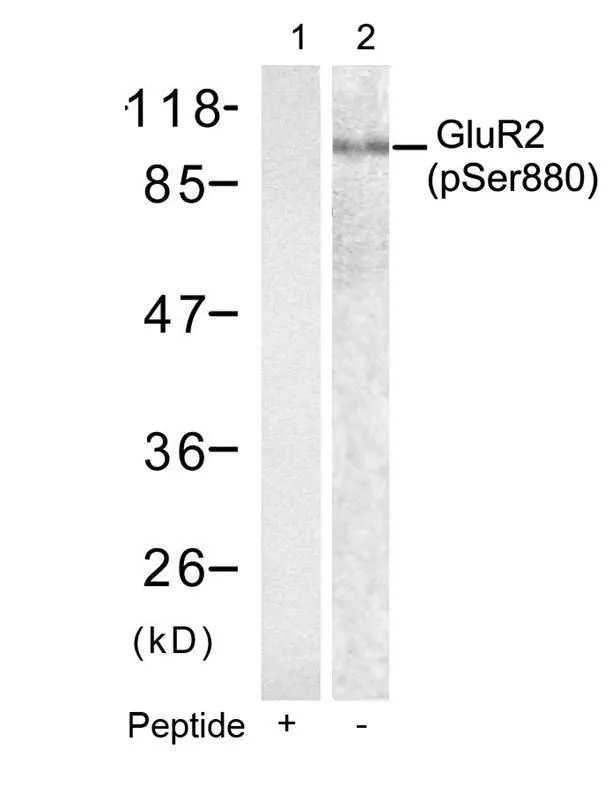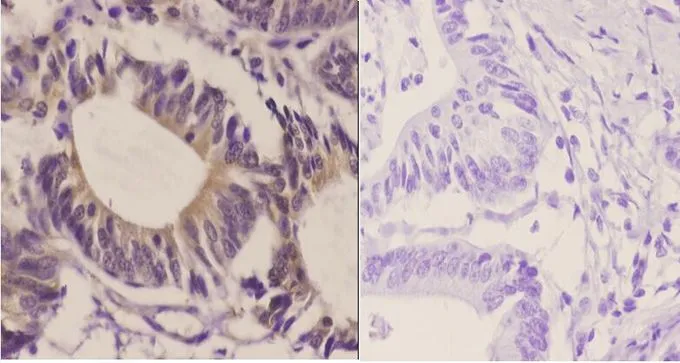
WB analysis of extracts from mouse brain tissue using GTX50311 GluR2 (phospho Ser880) antibody. Lane 1 : Primary antibody pre-incubated with the antigen specific peptide
GluR2 (phospho Ser880) antibody
GTX50311
ApplicationsWestern Blot
Product group Antibodies
ReactivityHuman, Mouse
TargetGRIA2
Overview
- SupplierGeneTex
- Product NameGluR2 (phospho Ser880) antibody
- Delivery Days Customer9
- Application Supplier NoteWB: 1:500-1:1000. *Optimal dilutions/concentrations should be determined by the researcher.Not tested in other applications.
- ApplicationsWestern Blot
- CertificationResearch Use Only
- ClonalityPolyclonal
- Concentration1 mg/ml
- ConjugateUnconjugated
- Gene ID2891
- Target nameGRIA2
- Target descriptionglutamate ionotropic receptor AMPA type subunit 2
- Target synonymsGLUR2, GLURB, GluA2, GluR-K2, HBGR2, NEDLIB, gluR-2, gluR-B, glutamate receptor 2, AMPA receptor subunit GluA2, AMPA-selective glutamate receptor 2, glutamate receptor, ionotropic, AMPA 2
- HostRabbit
- IsotypeIgG
- Protein IDP42262
- Protein NameGlutamate receptor 2
- Scientific DescriptionGlutamate receptors are the predominant excitatory neurotransmitter receptors in the mammalian brain and are activated in a variety of normal neurophysiologic processes. This gene product belongs to a family of glutamate receptors that are sensitive to alpha-amino-3-hydroxy-5-methyl-4-isoxazole propionate (AMPA), and function as ligand-activated cation channels. These channels are assembled from 4 related subunits, GRIA1-4. The subunit encoded by this gene (GRIA2) is subject to RNA editing (CAG->CGG; Q->R) within the second transmembrane domain, which is thought to render the channel impermeable to Ca(2+). Human and animal studies suggest that pre-mRNA editing is essential for brain function, and defective GRIA2 RNA editing at the Q/R site may be relevant to amyotrophic lateral sclerosis (ALS) etiology. Alternative splicing, resulting in transcript variants encoding different isoforms, (including the flip and flop isoforms that vary in their signal transduction properties), has been noted for this gene. [provided by RefSeq, Jul 2008]
- ReactivityHuman, Mouse
- Storage Instruction-20°C or -80°C,2°C to 8°C
- UNSPSC12352203



![ICC/IF analysis of SH-SY5Y cells using GTX03195 GluR2 antibody [GT1283]. Blue : DAPI for nuclear staining Dilution : 1:100](https://www.genetex.com/upload/website/prouct_img/normal/GTX03195/GTX03195_20210615_ICCIF_5_w_23053123_736.webp)

![Western Blot: Glutamate receptor 2 [Phospho-Ser880] Antibody [GTX48639] - rat brain homogenate showing specific immunolabeling of the ~100k GluR2 protein phosphorylated at Ser880 (control). Immunolabeling is blocked by preadsorption with the phospho-peptide used as antigen (Peptide) but not by the corresponding dephospho-peptide (not shown).](https://www.genetex.com/upload/website/prouct_img/normal/GTX48639/GluR2-subunit-phospho-Ser880-antibody-GTX48639-WB-1_w_23060823_176.webp)